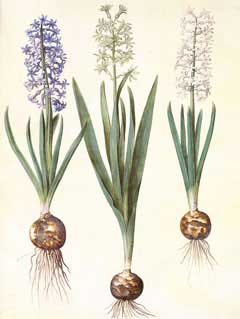 |
|
http://commons.wikimedia.org/wiki/File:Gc20_hyacinthos_orientalis.jpg |
 |
| http://en.wikipedia.org/wiki/User:Ram-Man |
Translate this page:
Summary
Bloom Color: Pink, Red. Main Bloom Time: Early spring, Mid spring. Form: Upright or erect
Physical Characteristics

 Hyacinthus orientalis is a BULB growing to 0.3 m (1ft) by 0.1 m (0ft 4in) at a slow rate.
Hyacinthus orientalis is a BULB growing to 0.3 m (1ft) by 0.1 m (0ft 4in) at a slow rate.
It is not frost tender. It is in flower from April to May. The species is hermaphrodite (has both male and female organs) and is pollinated by Bees.
Suitable for: light (sandy) and medium (loamy) soils and prefers well-drained soil. Suitable pH: mildly acid, neutral and basic (mildly alkaline) soils. It can grow in semi-shade (light woodland) or no shade. It prefers moist soil.
UK Hardiness Map
US Hardiness Map
Synonyms
Plant Habitats
Cultivated Beds;
Edible Uses
References More on Edible Uses
Medicinal Uses
Plants For A Future can not take any responsibility for any adverse effects from the use of plants. Always seek advice from a professional before using a plant medicinally.
None known
References More on Medicinal Uses
The Bookshop: Edible Plant Books
Our Latest books on Perennial Plants For Food Forests and Permaculture Gardens in paperback or digital formats.

Edible Tropical Plants
Food Forest Plants for Hotter Conditions: 250+ Plants For Tropical Food Forests & Permaculture Gardens.
More

Edible Temperate Plants
Plants for Your Food Forest: 500 Plants for Temperate Food Forests & Permaculture Gardens.
More

More Books
PFAF have eight books available in paperback and digital formats. Browse the shop for more information.
Shop Now
Other Uses
Dye Essential
An essential oil obtained from the flowers is used in perfumery[61, 171]. 1kg of the oil is obtained from 6,000kg of flowers[46]. A blue dye is obtained from the flowers[168].
Special Uses
Scented Plants
References More on Other Uses
Cultivation details
Landscape Uses:Border, Container, Massing, Rock garden, Specimen. Easily grown in a well-drained sandy soil in full sun[90, 200]. Prefers a moderately rich soil[1]. The dormant bulbs are fairly hardy and will withstand soil temperatures down to at least -5°c[214]. A very ornamental plant[1], there are many named varieties[200]. When grown outdoors in Britain the bulb often gradually deteriorates each year due to a lack of summer heat that is required to fully ripen the bulb[1]. Eventually they look more like a bluebell than a hyacinth[K]. Bulbs should be planted out 7cm deep in October[1]. The flowers have a strong sweet fragrance that can fill the air for a considerable distance[245]. Special Features:All or parts of this plant are poisonous, Suitable for cut flowers, Fragrant flowers.
References Carbon Farming Information and Carbon Sequestration Information
Temperature Converter
Type a value in the Celsius field to convert the value to Fahrenheit:
Fahrenheit:
The PFAF Bookshop
Plants For A Future have a number of books available in paperback and digital form. Book titles include Edible Plants, Edible Perennials, Edible Trees,Edible Shrubs, Woodland Gardening, and Temperate Food Forest Plants. Our new book is Food Forest Plants For Hotter Conditions (Tropical and Sub-Tropical).
Shop Now
Plant Propagation
Seed - best sown as soon as it is ripe in a cold frame in a light sandy soil[1]. If sown thinly, the seedlings can be left in their pots for the first year, though give them regular liquid feeds to make sure that they get sufficient nutrient. Prick out the seedlings about 3 to a pot and grow on for 1 - 2 more years before planting out into their permanent positions when they are dormant[K]. Division in the autumn. Plant the small offsets 5cm deep[1]. Larger bulbs can be replanted direct into their permanent positions, but it is best to pot up smaller bulbs and grow them on for a year in a cold frame before planting them out when dormant in late summer. Scooping and scoring.
Other Names
If available other names are mentioned here
Native Range
TEMPERATE ASIA: Israel, Lebanon, Syria, Turkey (south)
Weed Potential
Right plant wrong place. We are currently updating this section.
Please note that a plant may be invasive in one area but may not in your area so it's worth checking.
Conservation Status
IUCN Red List of Threatened Plants Status :

Growth: S = slow M = medium F = fast. Soil: L = light (sandy) M = medium H = heavy (clay). pH: A = acid N = neutral B = basic (alkaline). Shade: F = full shade S = semi-shade N = no shade. Moisture: D = dry M = Moist We = wet Wa = water.
Now available:
Food Forest Plants for Mediterranean Conditions
350+ Perennial Plants For Mediterranean and Drier Food Forests and Permaculture Gardens.
[Paperback and eBook]
This is the third in Plants For A Future's series of plant guides for food forests tailored to
specific climate zones. Following volumes on temperate and tropical ecosystems, this book focuses
on species suited to Mediterranean conditions—regions with hot, dry summers and cool, wet winters,
often facing the added challenge of climate change.
Read More
Expert comment
Author
L.
Botanical References
5093200
Links / References
For a list of references used on this page please go here
Readers comment
© 2010, Plants For A Future. Plants For A Future is a charitable company limited by guarantee, registered in England and Wales. Charity No. 1057719, Company No. 3204567.